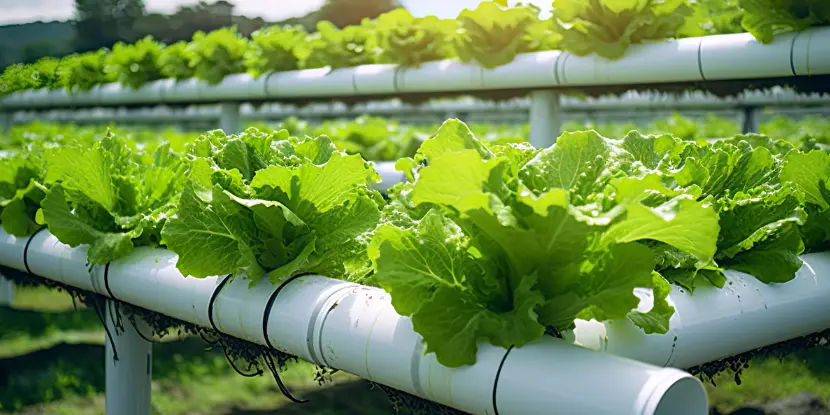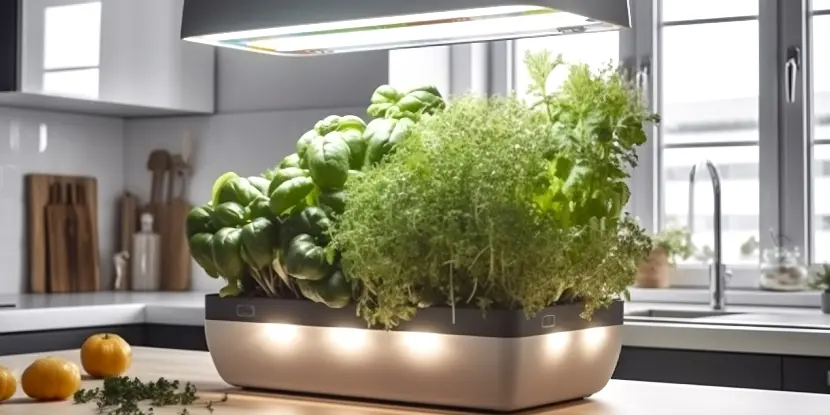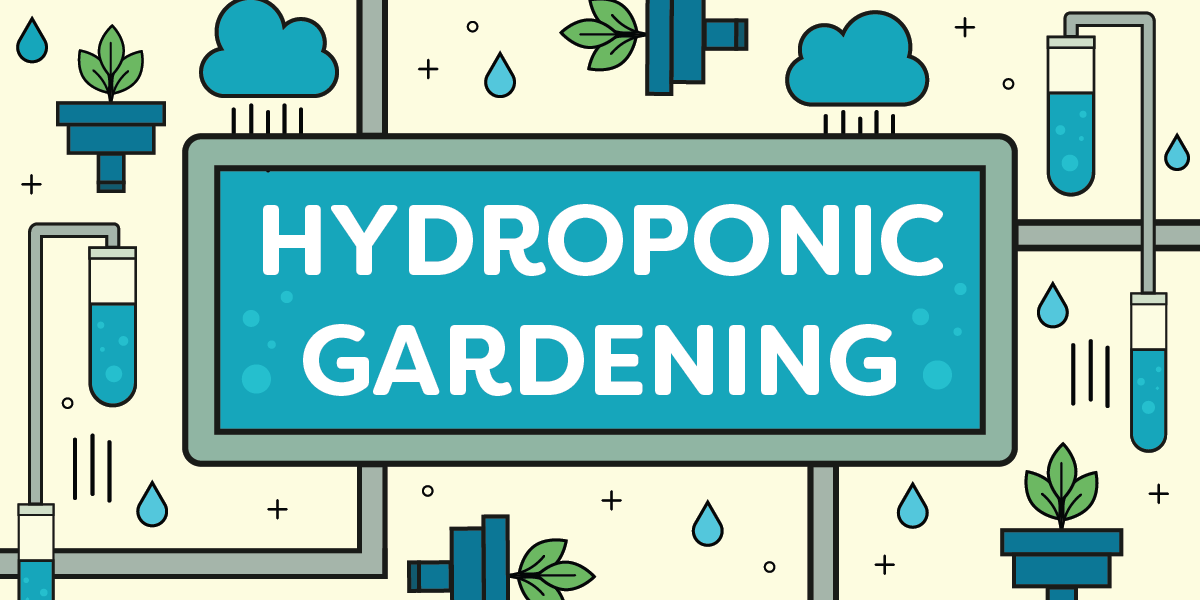Hydroponic gardening offers several advantages over traditional sod-busting, including:
- The efficient use of space
- Water conservation
- Better pest control
- Faster growth rates
Commercial farmers have embraced the technology. Chances are those juicy cherry tomatoes you bought on sale were grown hydroponically.
Certain vegetables with short growth cycles thrive in hydroponic systems. These include:
- Butterhead, romaine, and leaf lettuce
- Cherry tomatoes, grape tomatoes, and other small tomato varieties
- Compact cucumber varieties, such as mini or pickling cucumbers
- Bell peppers, jalapenos, and other sweet or hot pepper varieties
- Spinach and other leafy greens
- Herbs like basil, cilantro, and parsley

A small lettuce garden using hydroponic technology.
What Is Hydroponic Gardening?
In hydroponic gardening, plants are cultivated in nutrient-rich water solutions instead of soil. This method allows precise control over nutrient levels, pH balance, and environmental conditions.
- It gives plants direct access to essential nutrients and water.
- It eliminates the need for extensive root systems.
- It enables faster growth, higher yields, and year-round gardening.
- It requires less water than traditional gardening methods.
- It protects plants from soil-borne pests and diseases.

A hydroponic garden organized on shelves.
Getting Started
Choosing a System
As the demand for fresh produce grows, so does the technology for hydroponic gardening. Systems range from simple DIY setups to fully automated commercial operations.
These are the main types to consider:
Deep Water Culture (DWC)
Plants are suspended in a nutrient-rich solution while their roots are submerged. This constant water exposure is optimal for fast-growing plants.
Advantages: Simple to set up, low maintenance, and highly efficient for water and nutrient use.
Nutrient Film Technique (NFT)
A continuous flow of nutrient solution feeds the roots of plants secured in channels. This ensures roots have ample access to nutrients while also being exposed to oxygen.
Advantages: Efficient nutrient use, suitable for various plants, and easy to scale up or down.
Drip Systems
A slow drip of nutrient solution is delivered directly to each plant’s root zone using a recirculating setup or a run-to-waste system.
Advantages: Precise control over watering and nutrition, customizable for different plant types, and water conservation.

Commercial hydroponic lettuce growing.
Hydroponic Kits
Purchasing a hydroponic kit offers several benefits for beginners:
- Ease of Setup: Kits come with all the necessary components, reducing the complexity of starting from scratch.
- Cost-Effective: Buying a kit can be cheaper than purchasing individual components separately.
- Guidance and Support: Most kits include instructions or support resources.
- Optimized Systems: Kits are designed with optimal ratios and setups, drawing on expert knowledge to ensure better growth and yields.
Starting Small with Microgreens & Stacking Systems
Microgreen cultivation and stacking systems let beginners dip a toe in the water without committing to a full-scale hydroponic setup. Microgreens are harvested in their seedling stage, usually within 1-3 weeks after planting. They can be grown indoors with minimal equipment.
Stacking systems use multiple growing layers to maximize vertical space. They’re ideal for herbs, leafy greens, and small vegetables.
Both systems are available in kits.

A vertical hydroponic garden for lettuce.
Selecting Plants
Not all plants are suitable for hydroponic cultivation. Consider starting with crops like basil, spinach, and cherry tomatoes before progressing to more challenging vegetables.
Due to their short growth cycle, these plants are more forgiving. Plus, a successful harvest will motivate you for your next hydroponic adventure.
Building a Hydroponic System
Setup
- Lighting: Plants must have adequate natural sunlight or full-spectrum artificial lighting. LED grow lights are popular for their efficiency.
- Aeration: Oxygen must be supplied to the water through air stones or pumps.
- Water Circulation: A pump must circulate the water to prevent stagnation and ensure an even distribution of nutrients.
- pH Balance: The ideal pH range for hydroponic plants is between 5.5 and 6.5.
- Nutrient Solution: A balanced solution of essential nutrients for plant growth must be monitored and adjusted.

A space-saving tiered hydroponic garden.
Environment
- Temperature: The ideal range for hydroponically grown plants is 65-70°F during the day and 60-65°F at night.
- Humidity: The optimal humidity level varies depending on the plant type, but most thrive in humidity levels between 50% and 60%. Too much moisture can lead to fungal diseases, while too little can stress plants.
- Ventilation: Proper ventilation prevents mold and disease, especially in indoor setups.
- Pest Control: Hydroponic gardening doesn’t eliminate the risk of pests, so prevention strategies are a must.
Best Location
- Indoor: The best area is one with some access to natural light. Supplement with artificial light as necessary.
- Greenhouse: A greenhouse is ideal for larger setups. It provides natural light and regulates temperatures but requires environmental control systems for optimal growth.
- Outdoor: Some systems can be set up outdoors during the warmer months. They should be placed in a sheltered area to protect plants from extreme weather conditions.
Nutrient Solutions
Nutrient solutions are a critical component of hydroponic systems, providing plants with the essential minerals they need for growth. These solutions contain a balanced mix of nitrogen, phosphorus, potassium, and micronutrients like calcium, magnesium, and iron, tailored to the needs of hydroponically grown plants.
Commercial Availability
Pre-mixed solutions are available for different types of plants and growth stages. These commercial solutions ensure optimal plant health and yield.
Use & Maintenance
- Application: Follow the manufacturer’s instructions for dilution and application to your hydroponic system. The concentration might need adjustments based on the plant type, growth stage, and specific system requirements.
- Monitoring: Regularly check the nutrient solution’s pH and electrical conductivity (EC) to ensure the levels are within the ideal range for your plants. This helps them absorb nutrients.
- Adjustment and Replenishment: Adjust the pH using pH up or down solutions. Replenish the nutrient solution periodically to maintain proper nutrient levels.
- System Flush: Completely replace the nutrient solution every few weeks to prevent the buildup of salts and refresh the nutrients.
- Cleaning: Regularly clean your hydroponic system to prevent algae growth and the accumulation of unused nutrients, which can affect plant health.

A small hydroponic herb garden.
Non-Toxic Algae & Mineral Deposit Removal
Apply these non-toxic methods to maintain and clean your hydroponic system without harsh chemicals:
- Hydrogen Peroxide (H2O2): Adding food-grade hydrogen peroxide to the nutrient solution can kill algae without harming plants. It oxygenates the water, benefiting root health.
- Vinegar: White vinegar can remove mineral deposits from system parts. Dilute with water and use it to soak or scrub affected areas. Rinse thoroughly to prevent vinegar from entering your system.
- Manual Removal: Use a soft brush or sponge to gently scrub the surfaces.
- Preventive Measures: Increase air circulation, control light exposure (especially direct sunlight on nutrient reservoirs), and regularly clean system parts to prevent algae and mineral buildups.
Pest & Disease Control
While hydroponic systems are less vulnerable to pests and diseases than soil-based gardens, they’re not immune.
Common Pests in Southern California
- Spider Mites: These tiny arachnids thrive in warm, dry conditions and can severely damage or kill plants by sucking sap from the leaves.
- Non-Chemical Control: Increase humidity around your plants, as spider mites prefer dry conditions. Regularly rinse plants with water to physically remove mites and introduce predatory insects like ladybugs or lacewings.
- Aphids: Small, sap-sucking insects that cause stunted growth, leaf curl, and transmission of plant viruses.
- Non-Chemical Control: Wash plants with a jet of water to remove aphids. Introduce natural predators like ladybugs and parasitic wasps, which can significantly reduce aphid populations.
- Whiteflies: These insects feed on plant sap and excrete sticky honeydew, encouraging sooty mold growth on leaves.
- Non-Chemical Control: Use yellow sticky traps to catch adult whiteflies. Encourage natural enemies in the hydroponic environment, such as lacewings and predatory mites.
Common Diseases in Hydroponic Systems
- Powdery Mildew: A fungal disease that appears as white or gray powdery spots on the leaves and stems of plants.
Non-Chemical Control: Improve air circulation around your plants and reduce humidity levels to inhibit the fungus’s growth. Remove and destroy infected plant parts promptly. - Root Rot: Caused by waterlogged conditions and poor oxygenation, leading to brown, mushy roots and stunted plant growth.
Non-Chemical Control: Use air stones or pumps to oxygenate the nutrient solution. Regularly clean and maintain the hydroponic system to prevent the buildup of organic matter. - Botrytis (Gray Mold): This fungus affects many plant species, leading to gray mold on leaves, stems, and flowers.
Non-Chemical Control: Increase ventilation and reduce humidity in the growing space. Remove infected plant material immediately to prevent the spread of spores.
Maintenance & Troubleshooting
Maintaining a healthy and productive hydroponic system requires regular attention and care. Here are some essential maintenance tips and troubleshooting strategies to keep your system running smoothly:
Maintenance Tips
- Regular Checks: Perform daily visual inspections of your plants and equipment to spot any issues early.
- Nutrient Level Checks: Monitor and adjust nutrient levels weekly to meet your plants’ needs.
- pH and EC Monitoring: Check your nutrient solution’s pH and EC levels regularly, adjusting as necessary to maintain optimal conditions for plant growth.
- System Cleaning: Clean your system thoroughly between each crop cycle to prevent the buildup of pathogens and residue.
- Root Inspections: Regularly inspect the roots of your plants for any signs of disease or stress, such as discoloration or slime.
- Filter Cleaning: Clean filters periodically to ensure efficient water flow and prevent clogging, especially if you use tap water.
Troubleshooting Strategies
- Poor Plant Growth: Check for inadequate nutrient levels, incorrect pH, or low light conditions. Adjust as necessary.
- Yellowing Leaves: This could indicate a nutrient deficiency, usually nitrogen or iron. Check and adjust your nutrient solution’s composition.
- Stunted Growth or Wilting: Inspect the water supply and root health. Stunted growth can signify root rot or inadequate water or oxygen supply.
- Algae Growth: Reduce light exposure to nutrient solutions and clean your system. Consider adding a cover to your reservoir.
- Blocked Drippers or Nozzles: Regularly clean and check drippers or nozzles for blockages. Use filtered water to reduce the risk of blockages.
Harvesting Process & Indicators of Readiness
- Refer to the growth cycle information for each plant species. Most leafy greens are ready in 4-6 weeks, while fruiting plants may take longer.
- Leafy greens should have vibrant, fully-developed leaves. Many herbs offer the best flavor they flower.
- Fruiting plants like tomatoes or peppers are ready when they reach their full size and show the characteristic color of the variety. Flowers, like marigolds or lavender, should be fully bloomed but not wilting.
- If uncertain, you can sometimes perform a taste test on a small portion of the plant. This is especially true for herbs, where the flavor can be a strong indicator of readiness.
- Use clean, sharp scissors or shears to cut the plants. Be gentle to avoid damaging the plant structure, especially if you expect more growth for a second harvest.
FAQs About Hydroponic Gardening
Q: Is hydroponic gardening suitable for beginners?
Hydroponic gardening can be beginner-friendly, especially with proper research and preparation.
Q: Do I need a lot of space to start a hydroponic garden?
Not necessarily. You can set up hydroponic systems in a small space like a balcony or windowsill. Compact systems like vertical towers are also available.
Q: Are there any risks of contamination with hydroponic gardening?
Yes, if you don’t maintain the system. Regular cleaning and maintenance can mitigate the risks.
Q: Can you grow organic produce with hydroponic systems?
Yes, by using organic nutrient solutions and adhering to organic gardening practices.
Q: What types of plants are best suited for hydroponic gardening?
Most leafy greens, herbs, and small fruiting plants like tomatoes and peppers thrive in hydroponics. However, with the proper setup and care, you can grow a wide variety of plants hydroponically.
Q: How much does it cost to start hydroponic gardening?
Small DIY setups can be very affordable, while large or commercial systems require a significant investment in equipment and materials.
Q: How can you control pests in a hydroponic garden?
Pest control in hydroponic systems often involves preventative measures like sanitation and physical barriers. Introducing beneficial insects and organic pesticides can also be effective.
Q: Can hydroponic systems be automated?
Many aspects of hydroponic systems can be automated, including watering, nutrient delivery, and lighting. Automation can help maintain optimal growing conditions and reduce labor.

